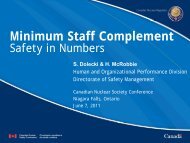Investigation of the Environmental Fate of Tritium in the Atmosphere
Investigation of the Environmental Fate of Tritium in the Atmosphere
Investigation of the Environmental Fate of Tritium in the Atmosphere
Create successful ePaper yourself
Turn your PDF publications into a flip-book with our unique Google optimized e-Paper software.
INVESTIGATION OF THE ENVIRONMENTAL FATE OF TRITIUM IN THE ATMOSPHERE<br />
<strong>of</strong> approximately 6 x 10 11 and 1.5 x 10 11 Bq per MW(e)a for airborne and liquid effluents,<br />
respectively, based on estimated releases over <strong>the</strong> life-time <strong>of</strong> <strong>the</strong> reactor (Gratwohl, 1973;<br />
UNSCEAR, 1977). In addition, when heavy water serves as both a coolant and a moderator,<br />
<strong>the</strong> complex system <strong>of</strong> heat exchangers and l<strong>in</strong>es can lead to l<strong>in</strong>e breakages and occasional<br />
spills, which may <strong>in</strong>troduce tritium to <strong>the</strong> environment (Jacobs, 1968).<br />
UNSCEAR (2000) presents tritium release data for HWR reactors over <strong>the</strong> 1990-94 period,<br />
which supports a typical total release <strong>of</strong> 7.5 x 10 11 Bq/MW(e) a. There is approximately<br />
order <strong>of</strong> magnitude variability around this value. Table 2.3 presents more recent tritium<br />
release data for Canadian CANDU generat<strong>in</strong>g stations. Most <strong>of</strong> <strong>the</strong>se stations are releas<strong>in</strong>g<br />
less than 7.5 x 10 11 Bq/MW(e) a, but still with<strong>in</strong> <strong>the</strong> range cited by UNSCEAR (2000).<br />
Table 2.3: <strong>Tritium</strong> Releases per MW(e)a for Canadian HWR Power Plants<br />
Generation or Release Picker<strong>in</strong>g Darl<strong>in</strong>gton Bruce Gentilly-2 Pt. Lepreau<br />
Power Generation<br />
(MW(e)a) 3094 3542 6516 675 640<br />
Year <strong>of</strong> <strong>Tritium</strong> Release: 2006 1 2006 1 2004 2 2002 3 2002 3<br />
Release to Air (Bq/a) 5.7 x 10 14 2.25 x 10 14 8.97 x 10 14 1.8 x 10 14 1.3 x 10 14<br />
Release to Water (Bq/a) 3.3 x 10 14 1.9 x 10 14 5.84 x 10 14 5.0 x 10 14 1.4 x 10 14<br />
Normalized Release<br />
(Bq/MW(e)a) 2.91 x 10 11 1.17 x 10 11 2.27 x 10 11 1.0 x 10 12 4.22 x 10 11<br />
1 Borromeo (2007). Darl<strong>in</strong>gton releases <strong>in</strong>clude HT from <strong>the</strong> tritium removal facility.<br />
2 Brown (2005)<br />
3 CNSC (2003)<br />
2.4.2.4 Gas-Cooled Reactors (GCRs)<br />
<strong>Tritium</strong> is produced by ternary fission <strong>in</strong> gas-cooled reactors (GCRs) at a rate <strong>of</strong><br />
approximately 7 x 10 11 Bq per MW(e)a (UN, ILO and WHO, 1983). Additional tritium on<br />
<strong>the</strong> order <strong>of</strong> approximately 7 x 10 9 Bq per MW(e)a <strong>in</strong> liquid effluents and 10 9 to 10 10 Bq per<br />
MW(e)a <strong>in</strong> airborne effluents can be produced through <strong>the</strong> activation <strong>of</strong> lithium <strong>in</strong> <strong>the</strong><br />
graphite moderator <strong>of</strong> GCRs (UNSCEAR, 1977).<br />
Gas-cooled reactors may use ei<strong>the</strong>r block or pebble-bed designs, referr<strong>in</strong>g to <strong>the</strong> packag<strong>in</strong>g<br />
<strong>of</strong> fuel <strong>in</strong> ei<strong>the</strong>r prismatic blocks or graphite-coated pebbles. Yook et al. (2006) compared<br />
tritium production rates for <strong>the</strong>se designs. Reported rates were <strong>in</strong> <strong>the</strong> order <strong>of</strong> 1 to 3 x 10 11<br />
Bq per MW(e)a by ternary fission, and 4 to 9 x 10 10 Bq per MW(e)a by activation <strong>of</strong> lithium,<br />
boron and helium, with no consistent difference <strong>in</strong> overall production among designs.<br />
BACK TO TABLE OF CONTENTS 18



